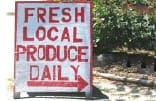 Natural…local…unprocessed…it all sounds good, but what do these terms really mean?
Natural…local…unprocessed…it all sounds good, but what do these terms really mean?
Unlike the term organic, which is defined according to standards established by the USDA’s National Organic Program, words like natural, local, and unprocessed have no standard definitions.
Local means whatever the vendor decides it means so if it’s important to you to know how far your food travels, you’ll need to ask how any given market or vendor defines the word. Most farmer’s markets have regulations determining what may be sold at the market–check in with the Market Master to find out what your market’s rules are. The farmer’s market where I shop is open year-round, for example, and has one set of rules in the winter and another in the summer. Starting the second week of June, farmers may only sell food that they have grown or produced on their own farms.
Natural means different things on different types of foods. When applied to packaged foods, the FDA simply requires that the food contain no added colors, artificial flavors, or synthetic ingredients. (That still leaves plenty of highly processed ingredients derived from natural substances.) When applied to meat or poultry, the USDA requires the meat to have no chemical preservatives or artificial colors or flavorings.
Processed has one meaning in the popular imagination (i.e., foods that bear only a distant resemblance to their raw ingredients) but, according to the 2010 Dietary Guidelines for Americans, a food is considered processed if it has been washed, cut, chopped, milled, heated, pasteurized, cooked, canned, frozen, dried, or packaged. By this definition, the milk and butter I buy from my local dairy farmer, along with the mesclun and carrots I buy at the farmer’s market, the stone cut bulgur wheat I buy at my local food coop, and the parsley I picked out of my garden this morning, are all processed foods.
A Little Common Sense Goes a Long Way
Obviously, foods can be all-natural without being particularly wholesome and most of the food you eat will be processed in some way. So let’s go off road. Here are a few signs that that you’re probably on the right track:
- The food has no label or ingredient list
- You could accurately guess most of the ingredients without looking at the label, based on how it looks and tastes
- The ingredient list reads more like a grocery list or recipe and less like the inventory for a chemistry lab
- The person selling it to you can tell you where it came from and how it was produced
- It won’t keep indefinitely without refrigeration
What would you add to my list?

Thanks for this post. I will be sharing this with our clients here.
Great post! Though I think the processing that goes into milk and dairy is far different from “washing” and “chopping.” Homogenized, pasteurized dairy is a highly processed product.
Highly processed? Really? Those WAPF folks are getting to you, Darya.
On a scale of 1 (berries picked from bushes in the backyard and eaten on the spot) to 10 (Funyuns), I’d put homogenized, pasteurized milk at about a 2.8